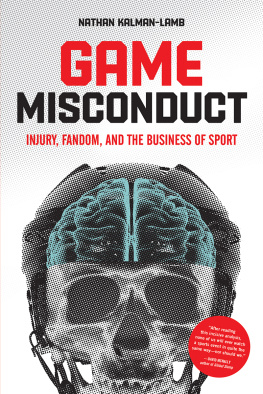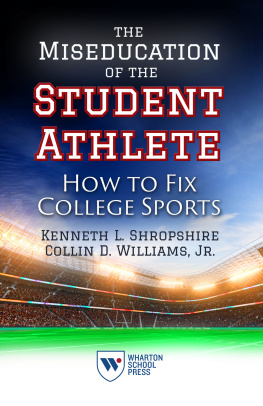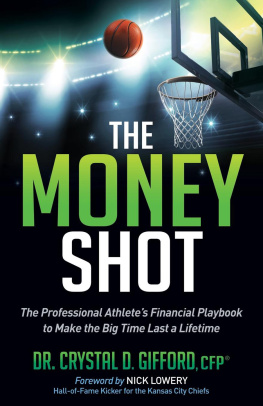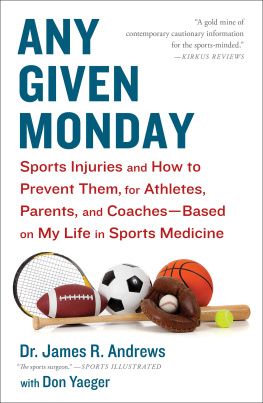GAME MISCONDUCT
INJURY, FANDOM, AND THE BUSINESS OF SPORT
NATHAN KALMAN-LAMB
FERNWOOD PUBLISHING
HALIFAX & WINNIPEG
Copyright 2018 Nathan Kalman-Lamb
All rights reserved. No part of this book may be reproduced or transmitted in any form by any means without permission in writing from the publisher, except by a reviewer, who may quote brief passages in a review.
Editing: Brenda Conroy
Cover design: Mike Carroll
eBook: tikaebooks.com
Printed and bound in Canada
Published by Fernwood Publishing
32 Oceanvista Lane, Black Point, Nova Scotia, B0J 1B0
and 748 Broadway Avenue, Winnipeg, Manitoba, R3G 0X3
www.fernwoodpublishing.ca
Fernwood Publishing Company Limited gratefully acknowledges the financial support of the Government of Canada, the Manitoba Department of Culture, Heritage and Tourism under the Manitoba Publishers Marketing Assistance Program and the Province of Manitoba, through the Book Publishing Tax Credit, for our publishing program. We are pleased to work in partnership with the Province of Nova Scotia to develop and promote our creative industries for the benefit of all Nova Scotians. We acknowledge the support of the Canada Council for the Arts, which last year invested $153 million to bring the arts to Canadians throughout the country.

Library and Archives Canada Cataloguing in Publication
Kalman-Lamb, Nathan, 1983-, author
Game misconduct: injury, fandom, and the business of sport / Nathan Kalman-Lamb.
Includes bibliographical references and index.
Issued in print and electronic formats.
ISBN 978-1-77363-006-9 (softcover).ISBN 978-1-77363-007-6 (EPUB). ISBN 978-1-77363-008-3 (Kindle)
1. SportsSocial aspects. 2. SportsEconomic aspects. 3. AthletesSocial conditions. 4. AthletesEconomic conditions. 5. Sports spectators.
I. Title.
GV706.5.K35 2018 796 C2017-907863-1
C2017-907864-X
CONTENTS
For all the athletes who work so that we may watch
ACKNOWLEDGEMENTS
I often think that this section is the most important part of any book. Every published text is, in at least minor ways, a combined effort, even if that fact is too seldom acknowledged. Certainly, Game Misconduct is fundamentally a work of collaboration.
As such, my most profound gratitude goes out to the individuals who so generously shared their stories with me: the eight former professional hockey players and eight sports fans. It is not an exaggeration to say that without their contributions, this book would have not been possible. I would also like to thank (but wont name in the interests of preserving anonymity) all of those who helped to put me in touch with the interviewees and others who ultimately chose not to be interviewed. My personal connections to professional hockey players are scant, so I relied a great deal on the benevolence of those who did have such connections and were generous in their willingness to share.
I owe a deep intellectual debt to my mentors at York University: To Anna Agathangelou and David McNally for teaching me about social reproduction, inspiring me with your own scholarship, and providing the encouragement this project required from its first inception in your respective classes to its ultimate publication. And, of course, above all, to Gamal Abdel-Shehid, always my teacher, mentor, collaborator, and friend. You enabled this project by giving me conviction in my work, a home in an alienating institution, and a constant sounding board for my ideas. So much of this book is owed to you.
Deeply sincere thanks to the great folks at Fernwood, who make the experience of publishing a book about as pleasant as I could possibly imagine it being. Thanks especially to Wayne Antony for his incredibly supportive editorial feedback; to Brenda Conroy for a really wonderful copy edit that managed to genuinely improve the accessibility and legibility of my prose; to Bev Rach for putting this project together and for putting up with my meddlesome queries; to Curran Faris for his efforts to make sure that this book has readers; and to the anonymous reviewer for a generous reading and insightful feedback.
I also feel a particular need to thank my colleagues in the Thompson Writing Program at Duke University for completely revitalizing my scholarly enthusiasm by providing the sort of supportive and collaborative intellectual environment I frankly did not believe could exist in the academy. I am particularly grateful to my cohort, and friends (alphabetically), Lisa Chinn, Mike Dimpfl, Marion Quirici, Sandra Sotelo-Miller, and Miranda Welsh for being so quick to embrace this Canadian radical, as well as to Jen Ansley, Brenda Baletti, Paolo Bocci, Sachelle Ford, Stefania Heim, Peter Pihos, and Amanda Pullum, among so very many other deeply appreciated colleagues, for their comradeship.
As this is a book fundamentally about labour, I also want to thank those I walked for months with on picket lines at York University in both 200809 and 2015 as part of cupe 3903 particularly my brother Gideon as well as all those who laboured to form, bargain, and operate the Duke Faculty Union in an incredibly hostile anti-union environment in the U.S. South. My experiences as a union member have been incredibly formative in my analysis and general understanding of what it means to labour.
Finally, thanks are owed most of all to my family. To my little Elizabeth, for constantly keeping every aspect of my professional life in perspective, including this one. And, of course, to my partner and interlocutor in all things, Jen Selk, for her invaluable insight and expertise as an interviewer and for providing all the forms of social reproductive labour that give us and this book life.
CHAPTER 1
SPORT, SPECTACLE, AND SACRIFICE
O n December 17, 2014, Chris Conte, player for the Chicago Bears of the National Football League, had this to say about the costs of athletic injury:
Ever since I was a little kid, its what Ive wanted to do In college, I didnt even graduate school because my senior year, I honestly let school be a casualty to that because I knew I had one opportunity to make it to the nfl , and I put everything into that. And I felt schools something I could figure out later.
As far as after football, who knows. My life will revolve around football to some point, but Id rather have the experience of playing and, who knows, die 10, 15 years earlier than not be able to play in the nfl and live a long life. Its something Ive wanted to do with my life and I wanted to accomplish. And I pretty much set my whole life up to accomplish that goal. So I dont really look toward my life after football because Ill figure things out when I get there and see how I am.
About a month before, Steve Nash, player with the Los Angeles Lakers of the National Basketball Association, posted the following statement on Facebook after announcing that he would sit out the entire season:
I definitely dont want to be a distraction, but I felt it best everyone heard from me in my own words.
I have a ton of miles on my back. Three bulging disks (a tear in one), stenosis of the nerve route and spondylolisthesis. I suffer from sciatica and after games I often cant sit in the car on the drive home, which has made for some interesting rides. Most nights Im bothered by severe cramping in both calves while I sleep, a result of the same damn nerve routes, and the list goes on somewhat comically. Thats what you deserve for playing over 1,300 nba games. By no means do I tell you this for sympathy especially since I see these ailments as badges of honour but maybe I can bring some clarity.









